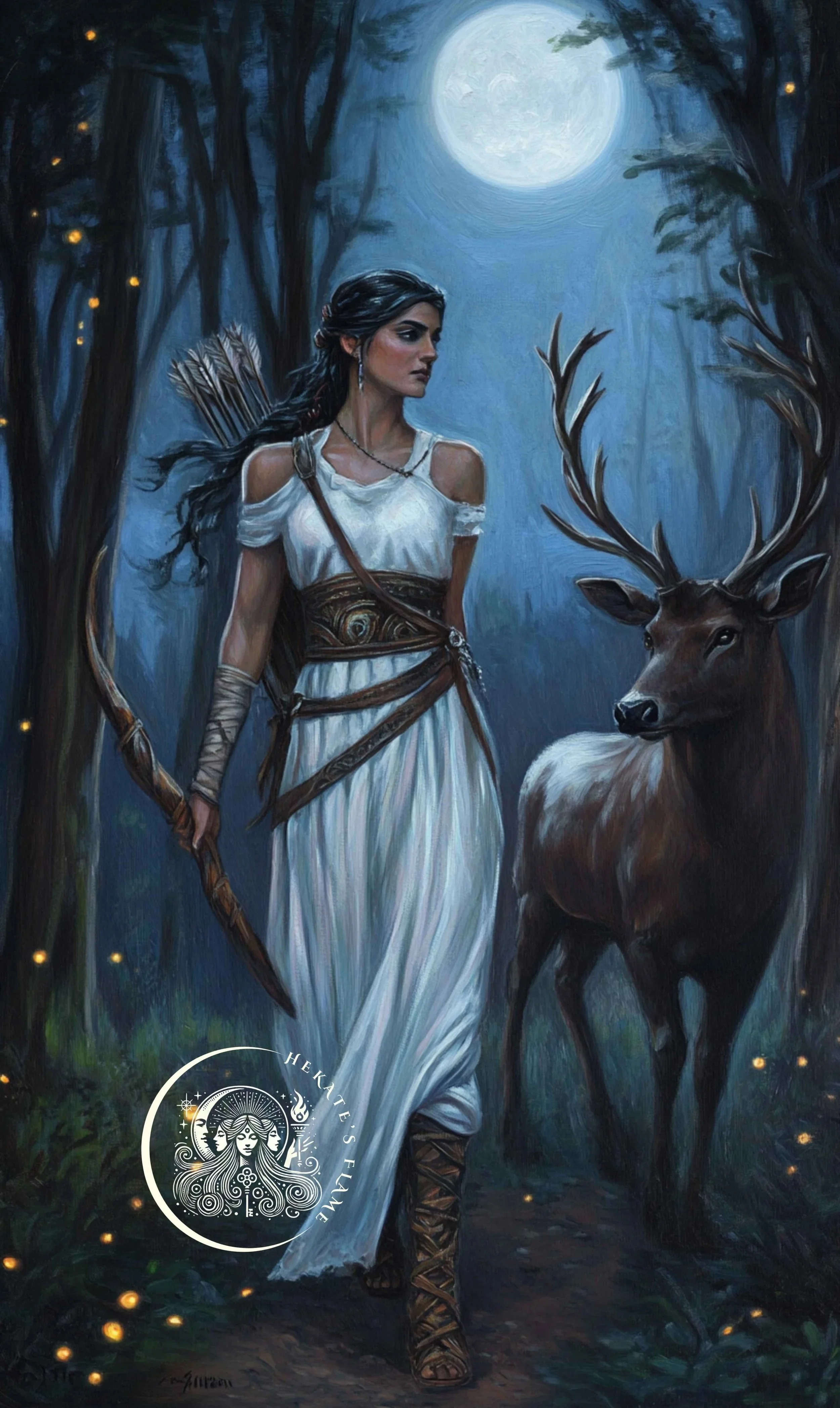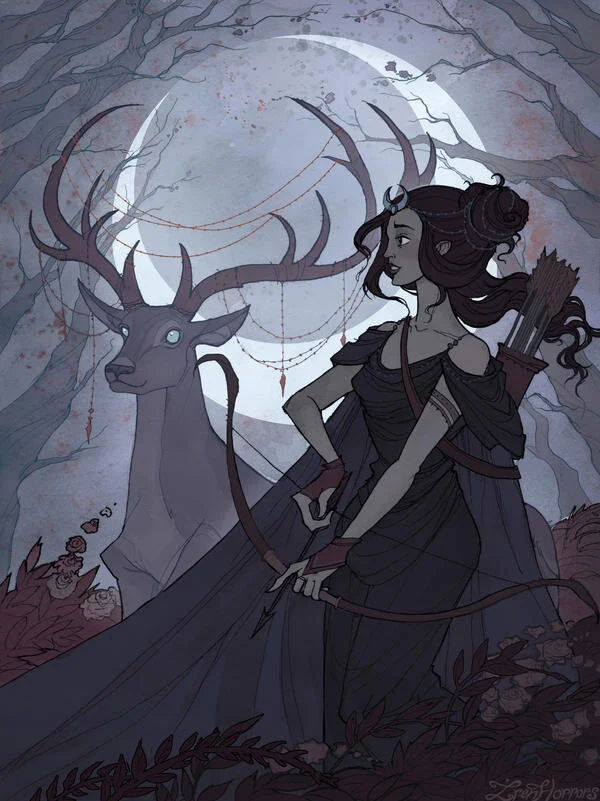Artemis as Archetype: Symbolism of the Goddess of the Hunt, Wilderness, Moon, and Childbirth
From Myth to Flame: A Handmade Candle for Artemis, Keeper of the Wild
Alongside my work as a psychotherapist, I am also the keeper of Hekate’s Flame Apothecary, where I bring myth into form through candle making.
Born of Greek and Anatolian roots, my lifelong reverence for story and ritual has guided me to craft candles as offerings, each one a vessel of archetype and alchemy, hand-poured with care.
The candle I created for Artemis, ‘Archer’s Breeze’, opens with the spice of clove and the brightness of bergamot, blooms with rose, lavender, and labdanum at its heart, and settles into a base of leather, tobacco leaves, and amber. Together, these notes evoke the wild grace of the huntress, the clarity of moonlit air, and the freedom of untamed forests. It is an offering to her presence, a way to keep Artemis near in the quiet rituals of daily life.
You are welcome to explore this candle, alongside a more in-depth telling of Artemis’s myth and story, on her page at Hekate’s Flame.
Artemis, the Lady of the Beasts
Wonderful artwork by IrenHorrors on DeviantArt (@irenhorrors)
Artemis, the divine Lady of the Beasts, enthralled me as a young girl with her enchanting tales of venturing into the mystical forest and communing with its wild inhabitants. Her multifaceted persona as the Greek goddess of the Hunt and Wilderness, the moon, and childbirth, with her Roman counterpart being Diana, was a constant source of fascination for me. Her fierce independence and nurturing spirit were perfectly balanced, making her an alluring figure who embodied the beauty and power of nature.
Artemis' Origins
In Olympian myth, the earliest reference to Artemis is attributed to the illustrious poet Hesiod in the ancient Greek literary tradition. In his seminal work, Theogony, Artemis is introduced as the twin sister of Apollo, born to the mighty god Zeus and the Titaness Leto. However, Hera, Zeus' wife, learned of his relationship with Leto and resolved to thwart the birth of her children.
Hera forbade Leto from giving birth on any land, which forced the brave Titaness to endure a long and arduous journey to find a suitable location. Ultimately, Leto sought refuge on the remote island of Delos, which, unmoored from the mainland, did not violate Hera's ultimatum. On this idyllic island, Leto gave birth to her precious twins, first Artemis and then Apollo, who would become revered deities in their own right.
Artemis, the Patron of Childbirth
(Image of artemisia vulgaris / mugwort from Pixabay)
Artemis' divine presence is intrinsically linked to the miracle of childbirth, as she courageously aided her mother in delivering her brother following a prolonged and onerous labor. Truly, Artemis' close affinity with the blessing of childbirth is reflected in the very name of the medicinal herb that is employed to stimulate labor contractions - the renowned mugwort, also referred to as artemisia.
Artemis, the Virgin Huntress
Artemis' chaste nature was renowned throughout the land. As a virgin huntress, she became the guardian of young girls and women. Her divine functions were reflected in the many names and titles bestowed upon her by the ancient Greeks. She was known as Agroterê (Ἀγροτέρα), the goddess of the hunt, Pheraia (Φεραία), the protector of beasts, Orsilokhia (Ορσιλοχία), the faithful helper in childbirth, and Aidoios Parthenos (Αἰδοῖος Παρθένος), the most revered of virgins.
Artemis, the Vengeful
Artemis & Actaeon
The theme of divine retribution, meted out by the vengeful goddess, was popular for ancient Greek artists in pottery and painting. One of the most widely recounted tales of this kind was that of Artemis and Actaeon.
The story tells of a young Theban hunter named Actaeon, who chanced upon Artemis and her nymph entourage while bathing in a river. Upon catching a glimpse of the naked goddess, Actaeon was swiftly punished by Artemis for his impudence. The vengeful deity transformed the hunter into a stag. He was thereafter pursued and torn apart by his pack of hunting hounds. This myth is a striking example of Artemis' unwavering commitment to safeguarding the virtue of sacred chastity.
Artemis & Niobe
Another example of Artemis' wrath is evident in the tale of Niobe, inspired by her desire to defend her mother's honor. The queen of Boeotia, Niobe, had twelve children - six boys and six girls - and she boasted to Leto, Artemis' mother, that she was a better mother than her since she had twelve children compared to Leto's two.
In Ancient Greece, there was no bigger sin than exhibiting hubris toward the gods. So Artemis and Apollo unleashed their divine wrath upon Niobe's offspring to avenge this arrogance. With his golden bow, Apollo annihilated the six sons. At the same time, Artemis, wielding her silver arrows, took care of the six daughters.
As a result of her heedless boasting, Niobe was left with no children, having paid the price for her pride. The sorrowful mother wept so much that the gods transformed her into a waterfall to relieve her suffering and symbolize divine retribution against hubris.
Artemis & Kallisto (Callisto)
Betrayal was another trigger for Artemis's wrath, as seen in the case of Kallisto, one of Artemis's chaste companions. Kallisto's offense was being seduced by Zeus, unbeknownst to the other gods. Only when Artemis spotted Kallisto bathing and noticed her pregnancy was the truth revealed. As a consequence, Artemis turned Kallisto into a bear, and she gave birth to a son, Arkas (Arcas), in this form. On the other hand, Zeus transformed Kallisto into the constellation of the Bear, Arktos.
For more on internalized misogyny in ancient Greece, please visit my post on Athena and Medusa.
Artemis' Symbols
(Art by Sieskja on DeviantArt)
Artemis, the queen of beasts and nature, held a special reverence for the deer, often depicted riding in a chariot pulled by these sacred animals. The boar was also considered a sacred creature and served as a means for the goddess to unleash her divine fury - as seen in the infamous Calydonian boar hunt. The she-bear was another animal that held significance to Artemis. Thus, one may often find a magnificent stag, a mighty bear, a ferocious wild boar, or a loyal hunting dog at her side. Artemis also associated many sacred birds with her, such as guineafowls and partridges.
However, her symbolic associations extend beyond the animal kingdom, including cypress trees, asphodel, palm trees, and amaranth. The crescent moon would grace her forehead like a celestial crown.
Artemis as an Archetypal Representation: Untamed, Fierce, and Focused
In terms of archetypes, Artemis embodies the essence of nature itself: raw and untamed, fiercely independent, and unyielding in her focus. Often depicted with her bow at the ready, she stands poised to release her silver arrows with deadly accuracy. Artemis' association with the bow and arrow imbued her with the spirit of a seeker. However, her thirst for exploration is not bound by societal norms or collective expectations.
(Artwork by Abigail Larson on DeviantArt)
Rather, she emanates solitary energy, finding solace in her own company and that of her chosen nymphs rather than in the company of society. Her self-reliance is renowned, and she embodies a spirit of non-conformity and individualism, rejecting societal norms and expectations that may seek to constrain her. Instead, Artemis boldly charts her own course and sets her sights on personal aspirations with unwavering determination and unmatched precision.
Artemis epitomizes an innate capacity for unyielding dedication and unwavering attention toward the issues she holds close to her heart, coupled with resolute courage to fight for what she deems just. Revered as the "Protectress," she would not rest until those who harmed pregnant animals were brought to justice.
Artemis was also a patron of young girls and women. Her steadfast devotion to female solidarity and companionship is widely celebrated unless the male playwrights have her turn on her own. (Again, for more on internalized misogyny in ancient Greece, please visit my post on Athena and Medusa.)
In contrast to the commonly held belief that Artemis lacks intimacy and emotional attachment to others, her capacity for deep intimacy lies in her fierce devotion to the causes, people, and animals she loves and protects suggests otherwise. Artemis is deeply connected to the natural world, including her forests, streams, and the moon. This bond is so strong that she is often portrayed as a ruthless avenger and spiritual executioner fueled by righteous rage. In some stories, her punishment for offenses against her causes is far more severe than the offense itself, demonstrating her unyielding commitment to environmental justice.
Inviting Artemis Within
Artemis embodies many virtues, from perseverance and autonomous exploration to an unwavering devotion to safeguarding our cherished causes and loved ones. In life, we too can draw upon these traits when confronted with the task of carving new paths, completing a challenging project, or advocating for the vulnerable and underprivileged among us.
Have you recognized these parts - perseverance, tenacity, devotion - within yourself?
If yes, how have they manifested in your life?
How, if willing to do so, could you nurture and honor these parts of yourself more?
Furthermore, how can you honor and nurture this part of yourself?
As we continue to reflect on Artemis, we can consider how she has shown up in our lives.
What might Artemis mean to you personally?
Has she graced your dreams?
If so, what message might she be trying to impart?
Warmly,
Anny
🦉🏹🌙
Kindly note: The information included in this blog is not intended nor implied to be a substitute for mental health services. Please consult with a qualified professional to determine the appropriateness of the information for your own life experiences or if you have any questions.
References
Bolen, J. S. (2004). Goddesses in everywoman: Powerful archetypes in women's lives. Harper Collins.
Cavendish, R. (1983). Man, myth and magic: the illustrated encyclopedia of mythology, religion and the unknown. Marshall Cavendish.
Downing, C. (1981). The goddess: Mythological images of the feminine. Crossroad.
Spretnak, C. (1992). Lost goddesses of early Greece: A collection of pre-Hellenic myths. Beacon Press.





